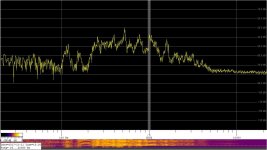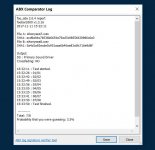It is usually assumed that triangular dither changes quantization distortion into something that's indistinguishable from additive noise, but as far as I know no-one has ever checked that with blind listening tests.
It shouldn't be difficult to create two versions of an audio file, one with triangular dither quantized to, say, 7 bits and one with 11th-order dither quantized to 8 bits (one bit more). The noise levels will then be exactly the same, but the 11th-order version has smaller quantization steps and is statistically closer to true additive noise; the first eleven moments of the error caused by dither and quantization are then independent of the signal, rather than only the first two moments.
Is anyone interested in blindly comparing such files?
It shouldn't be difficult to create two versions of an audio file, one with triangular dither quantized to, say, 7 bits and one with 11th-order dither quantized to 8 bits (one bit more). The noise levels will then be exactly the same, but the 11th-order version has smaller quantization steps and is statistically closer to true additive noise; the first eleven moments of the error caused by dither and quantization are then independent of the signal, rather than only the first two moments.
Is anyone interested in blindly comparing such files?
If you get no response we can move this over to 'Everything Else' which is where the majority of such threads seem to live... and they seem to get a fair response.
I got only two responses so far including yours, so maybe moving it is a good idea.
there is this...
Wannamaker is surprisingly readable for a PhD thesis -
http://www.digitalsignallabs.com/phd.pdf
but for the lazy:
For audio signal processing purposes, there seems to be little point in rendering any moments of the total error other than the first and second independent of the input. Variations in higher moments are believed to be inaudible and this has been corroborated by a large number of psycho-acoustic tests conducted by the authors and others [13, 21]. These tests involved listening to a large variety of signals (sinusoids, sinusoidal chirps, slow ramps, various periodically switched inputs, piano and orchestral music, etc.) which had been requantized very coarsely (to 8 bits from 16) in order to render the requantization error essentially independent of low-level non-linearities in the digital-to-analogue conversion system through which the listening took place. In addition, the corresponding total error signals (output minus input) were used in listening tests in order to check for any audible dependences on the input. Using undithered quantizers resulted in clearly audible distortion and noise modulation in the output and error signals…
When 2RPDF [ triangle PDF ] dither was employed, no instance was found in which the error was audibly distinguishable from a steady white noise entirely unrelated with the input...
Admittedly, these tests were informal, and there remains a need for formal psychoacoustic tests of this sort involving many participants under carefully controlled conditions.
The use of of non-subtractive, iid 2RPDF [ triangle PDF ] dither is recommended for most audio applications requiring multi-bit quantization or requantization operations, since this type of dither renders the power spectrum of the total error independent of the input, while incurring the minimum increase in error variance.
[13] Brinton, L.K., “Nonsubtractive Dither,” M.Sc. Thesis, Dept. of Elec. Eng.,
Univ. of Utah, Salt Lake City, UT (1984 Aug.).
[21] Wannamaker, R.A., “Dither and Noise Shaping in Audio Applications,”
M.Sc. Thesis, Dept. of Physics, Univ. of Waterloo, Waterloo, ON, Canada,
(1990 Dec.).
Last edited:
Thanks for the literature references! In the section that you quoted, the sentence "Admittedly, these tests were informal, and there remains a need for formal psychoacoustic tests of this sort involving many participants under carefully controlled conditions" seems a bit vague to me. Is there any information on whether the tests that they did were blind tests and whether there were subjects in the test who expected to be able to hear higher moments?
I got only two responses so far including yours, so maybe moving it is a good idea.
So lets see
Is anyone interested in blindly comparing such files?
Sure! I am highly interested.
OK, I've put two versions of a short fragment of I do like to be beside the seaside on WeTransfer:
WeTransfer
They'll be there until 18 November 2017.
If you think you hear a difference or that you might hear a difference, please do an ABX test using abx under Linux or the Foobar ABX plugin under Windows and report the results of all such trials in this thread.
WeTransfer
They'll be there until 18 November 2017.
If you think you hear a difference or that you might hear a difference, please do an ABX test using abx under Linux or the Foobar ABX plugin under Windows and report the results of all such trials in this thread.
OK, I've put two versions of a short fragment of I do like to be beside the seaside on WeTransfer:
WeTransfer
They'll be there until 18 November 2017.
If you think you hear a difference or that you might hear a difference, please do an ABX test using abx under Linux or the Foobar ABX plugin under Windows and report the results of all such trials in this thread.
Marcel, have you checked (listened to) the files?? Something is going wrong, there is a noise like a hell in both of them. See spectrum.
Attachments
OK, over my doubts, this is my one and only attempt.
Code:
foo_abx 2.0.2 report
foobar2000 v1.3.7
2017-11-11 16:53:51
File A: silverysea7.wav
SHA1: ecd9a04e7b536b6654a75ad7e98556429986c6a3
File B: silverysea8.wav
SHA1: 5a4d1a92ecde5c951aaa0b40ae83c6fc716e9d8f
Used DSPs:
Resampler (PPHS)
Output:
WASAPI (event) : Speaker (USB Sound Blaster HD), 24-bit
Crossfading: NO
16:53:51 : Test started.
16:54:47 : 01/01
16:54:55 : 02/02
16:55:07 : 03/03
16:55:18 : 04/04
16:55:27 : 05/05
16:55:33 : 06/06
16:55:40 : 07/07
16:55:46 : 08/08
16:55:52 : 09/09
16:56:00 : 09/10
16:56:06 : 09/11
16:56:11 : 10/12
16:56:11 : Test finished.
----------
Total: 10/12
Probability that you were guessing: 1.9%
-- signature --
58bbbfc2a8e1991b30fc97ddbc3dd440bb388a15
Last edited:
By the way, which one sounds the noisiest to you?
Subjectively the 2nd one, silvery8
As a sanity check, I just downloaded the files, subtracted the original signal and determined the RMS level of the noise produced by the dithered course quantization. The result was -39.12 dB with respect to the RMS level of a full-scale sine wave for silvery7 and -39.14 dB with respect to the RMS level of a full-scale sine wave for silvery8. In theory it should be -39.1339 dB for both files.
The peak level of the noise is quite different, though: -32.63 dB for silvery7 and -29.28 dB for silvery8 with respect to the full-scale level (the real full scale, not the RMS value of a full-scale sine wave). The theoretical values are -32.6018 dB and -26.5812 dB, respectively, but that -26.5812 dB will almost never occur because it requires all eleven random processes that make the eleventh-order dither and the round-off error to be at their maximum and in the same direction simultaneously.
I think this shows that the subjective noise level depends on the probability distribution as well as on the RMS value. That's actually why the ITU-R 468 standard prescribes a quasi-peak detector rather than an RMS detector. It also means that we're not going to find out anything about the audibility of the higher-order moments this way, because I don't know how to subjectively level match the noise.
In any case, you didn't complain about distortion, so apparently the dithered quantization error sounded like noise to you for both cases.
Thanks for participating!
The peak level of the noise is quite different, though: -32.63 dB for silvery7 and -29.28 dB for silvery8 with respect to the full-scale level (the real full scale, not the RMS value of a full-scale sine wave). The theoretical values are -32.6018 dB and -26.5812 dB, respectively, but that -26.5812 dB will almost never occur because it requires all eleven random processes that make the eleventh-order dither and the round-off error to be at their maximum and in the same direction simultaneously.
I think this shows that the subjective noise level depends on the probability distribution as well as on the RMS value. That's actually why the ITU-R 468 standard prescribes a quasi-peak detector rather than an RMS detector. It also means that we're not going to find out anything about the audibility of the higher-order moments this way, because I don't know how to subjectively level match the noise.
In any case, you didn't complain about distortion, so apparently the dithered quantization error sounded like noise to you for both cases.
Thanks for participating!
Last edited:
I think that may be the idea Pavel. The noise sounds very different between the two. I listened via laptop and earbuds.
Mooly, did you notice any differences other than the subjective difference in white noise level that PMA reported?
- Status
- This old topic is closed. If you want to reopen this topic, contact a moderator using the "Report Post" button.
- Home
- General Interest
- Everything Else
- High-order dither listening test

